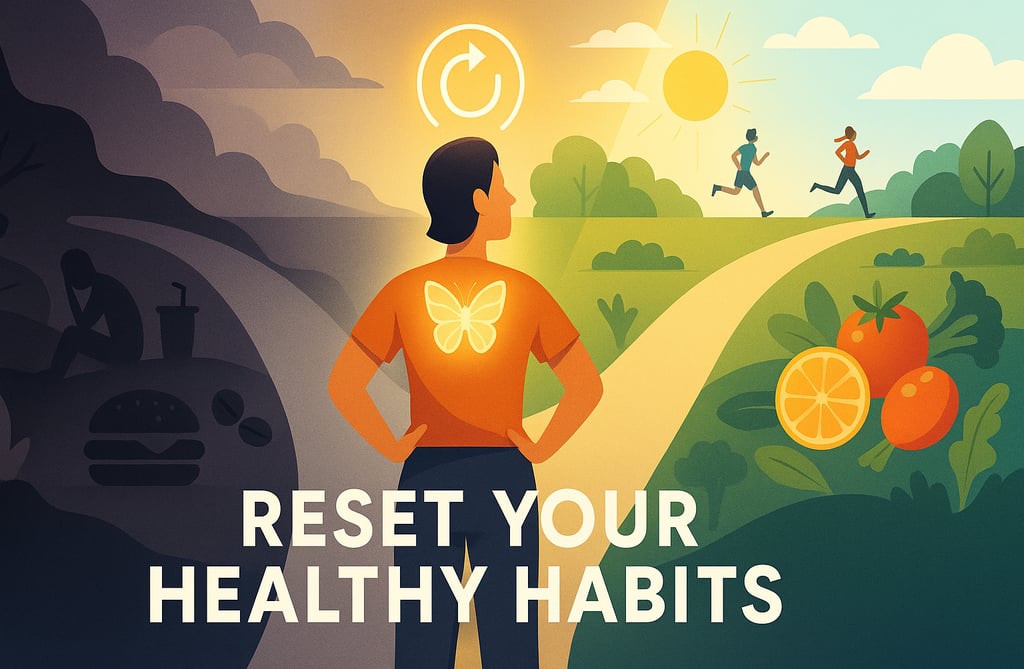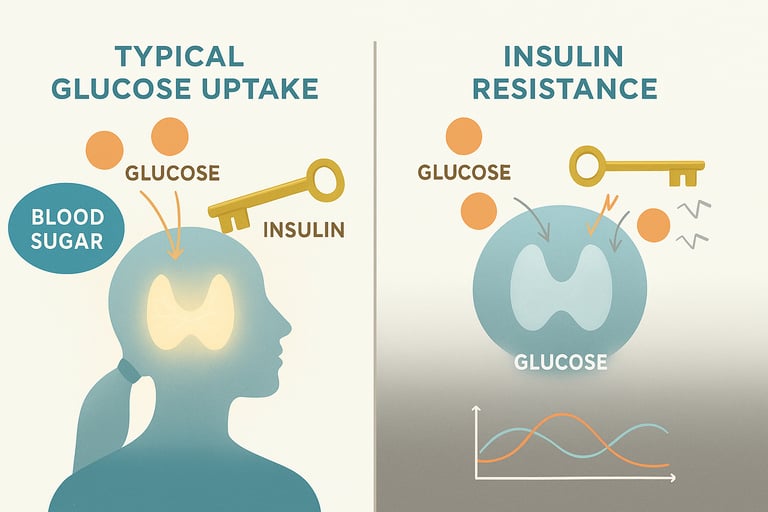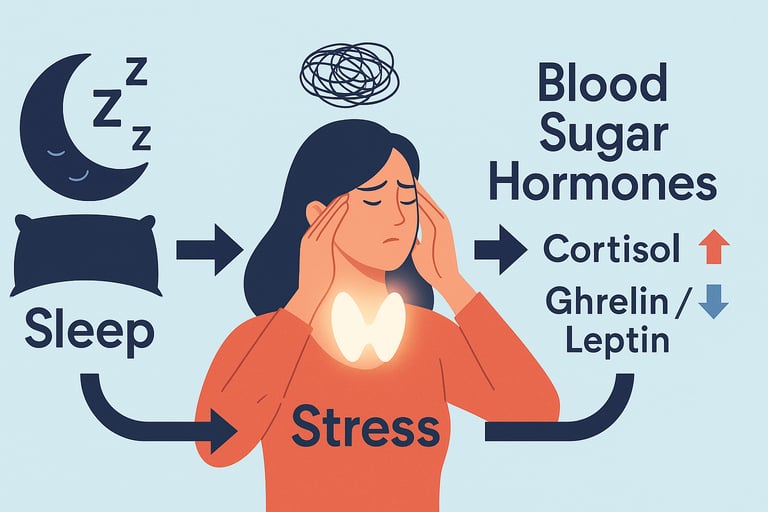Reversing Prediabetes Naturally Your Definitive Guide to Reclaiming Blood Sugar Balance
Discover how to reverse prediabetes naturally with this comprehensive guide to diet, exercise, and lifestyle changes. Reclaim your blood sugar balance and prevent type 2 diabetes. Start your journey today!
10/5/20259 min read


The Silent Alarm Managing Prediabetes and Your Power to Make a Difference
Consider a soft flashing light on your car's dashboard. It is not engine catastrophe, but it is an indicator that all is not well and must be fixed before catastrophe happens. For many Americans, prediabetes is the flashing light. It's a situation where your blood glucose is too high, but not high enough to be considered type 2 diabetes. Based on the Centers for Disease Control and Prevention (CDC), over 1 out of every 3 American adults almost 98 million people have prediabetes, and a whopping 80% don't know. That's a silent epidemic, a time bomb in waiting that, if left unaddressed, often leads to more serious health issues.
But the empowering reality is this: A diagnosis of prediabetes is not a death sentence. It's an wake up call, a never before seen opportunity to press the reset button on your health. This isn't a question of radical, unrealistic deprivation; it's a question of paying attention to your body and making smart, natural adjustments that can safely undo prediabetes and set the stage for sustainable blood sugar control. In this comprehensive guide, we'll demystify prediabetes, explore its root causes, and equip you with practical solutions your kitchen to your lifestyle to reclaim your health and sidestep the path to type 2 diabetes.
The Short Version
Prediabetes is reversible: It's an opportunity window to postpone Type 2 diabetes through lifestyle changes.
Diet is fundamental: Focus on whole foods, fiber, and lean protein and reduce refined sugar and processed carbohydrates.
Physical activity is medicine: Regular exercise powerfully increases insulin sensitivity and glucose regulation.
Well being is overall: Sleep, stress management, and hydration each play significant, often overlooked, roles in blood sugar regulation.
Decoding Prediabetes: What It Is and Why It Matters
As an introduction to solutions, let's learn about the problem. Our bodies are incredibly clever machines, and one of their most vital mechanisms has to do with how they handle glucose, the sugar we derive from what we eat. Glucose is our primary fuel, and the insulin hormone from our pancreas acts as a key, unlocking our cells so glucose may gain entry to provide us with energy. In prediabetes, this lovely system begins to fail.
The Numbers Don't Lie Diagnosing Prediabetes
Prediabetes is typically found by a series of significant blood tests. You could have prediabetes if your,
Fasting Plasma Glucose (FPG) test is 100-125 mg/dL. A normal fasting is below 100 mg/dL.
Oral Glucose Tolerance Test (OGTT), which measures blood sugar before and two hours after drinking a glucose beverage, shows a result of 140-199 mg/dL. A two hour OGTT result that is normal is below 140 mg/dL.
A1C test shows an average 2-3 months' blood sugar level as 5.7% to 6.4%. The healthy A1C is below 5.7%.
These numbers aren't arbitrary; they represent a state of insulin resistance. When you're insulin resistant, your cells aren't receiving the signal from insulin as rapidly. Your pancreas, trying to compensate, works overtime, secreting more and more insulin in a futile attempt to control blood sugar. This overwork eventually destroys the insulin,making cells, leading to permanently elevated blood sugar and, eventually, type 2 diabetes.
The Slippery Slope From Prediabetes to Type 2
Why is prediabetes such a big deal? Because it's a stepping stone to type 2 diabetes, a chronic condition that can lead to severe complications, including heart disease, stroke, kidney failure, nerve damage, and vision loss. The American Diabetes Association (ADA) notes that unless treated, many with prediabetes will eventually develop type 2 diabetes within five to ten years. Prediabetes not only predisposes you to diabetes but to heart disease and stroke before a full diagnosis of diabetes. Waiting for the red flags is equivalent to waiting until you're stranded on the side of the road for that car dashboard light.
Nourishing Your Way Back The Power of Food
When we talk about reversing prediabetes naturally, eating is typically the first, and best, arena where change can start. View your plate not as a source of comfort, or merely survival, but as a tool, a daily prescription for metabolic health. The best part: no starvation or extreme diets, but a thoughtful reconsideration of what fuels your body.
The Plate Makeover What to Eat (and What to Limit)
Adopt Whole, Unprocessed Foods: This is the foundation. Prioritize foods in their purest form: fresh vegetables, fruits, lean proteins, and whole grains. These foods are high in fiber, vitamins, and minerals, which delay the absorption of sugar and create long lasting energy. The CDC's National Diabetes Prevention Program has reinforced how food modifications can be highly beneficial, often resulting in a 5-7% weight loss, which cuts diabetes risk substantially.
Fiber is Your Friend: Soluble and insoluble fibers are essential. Soluble fiber, seen in oats, beans, apples, and nuts, creates a gel in water that slows down digestion and avoids peaking blood sugar levels. Insoluble fiber, found in whole grains and most vegetables, provides bulk and supports digestive health. Aim for 25-38 grams of fiber per day.
Lean Protein for Fullness and Balance: Include foods like chicken, fish, legumes, lentils, and tofu. Protein keeps you full, reduces hunger, and influences blood sugar less than carbohydrates.
Healthy Fats are a Must: Avocados, nuts, seeds, and olive oil have essential fatty acids, help maintain cell function, and keep you full without spiking blood sugar.
Restrict Processed Carbohydrates and Refined Sugars: This is probably the most significant cut. Soda with sugar, sweets, white bread, baked goods, and processed foods flood your body with glucose rapidly, getting your pancreas in hyperdrive. These are the largest offenders of insulin resistance.
Timing Is Everything Wise Eating Habits
Not only what you're consuming matters, but so does how and when you consume. Consider these habits:
Portion Control: Even healthy foods can total excess calories and glucose when consumed too much. Practice recognizing correct serving sizes.
Regular Meals: Missed meals will tend to lead to overconsumption of later meals and erratic blood sugar levels. Attempt regular meal times.
Mindful Eating: Pay attention to your body's signals of hunger and fullness. Eat slowly, savor your food, and refrain from distraction. Averts overeating and makes digestion better.
Move Your Body, Balance Your Blood Sugar
If diet is the framework, exercise is the scaffolding that supports your house of health. Exercise is a potent tool to conquer prediabetes naturally because it attacks insulin resistance head-on. During exercise, your muscles use glucose as fuel, really extracting it from your blood. This makes your cells more sensitive to insulin, i.e., your pancreas doesn't have to work as hard.
The Exercise Prescription It's Not All About the Gym
No need to become an overnight Olympic athlete. Be consistent and have fun with it.
Aerobic Exercise: A minimum of 150 minutes of moderate-intensity aerobic exercise a week. Some examples are brisk walking, cycling, swimming, dancing, or jogging. Take three 10 minute walks each day. Even regular exercise, the CDC states, can reduce the risk for type 2 diabetes by 58% in individuals at high risk.
Strength Training: Add strength training a minimum of two times per week. Gaining muscle mass is highly beneficial since muscle tissue is more metabolically active and utilizes more glucose than fat tissue. This can involve weightlifting, resistance bands, or body-weight exercises like squats and push ups.
Daily Movement: Don't underestimate the influence of non exercise activity thermogenesis (NEAT). Take the stairs rather than the elevator, park a little further away, stand up and stretch frequently, or pace while on phone calls. These bursts of activity accumulate.
Stress, Sleep, and Sugar The Hidden Link
While diet and exercise are most crucial, two often overlooked players in your blood sugar game can have a significant impact, sleep and stress. Think of them as the air in your house unseen but necessary.
Stress Management: Under stress, your body will secrete hormones like cortisol, raising blood sugar levels to make energy accessible to an anticipated threat. Chronic stress can lead to chronically elevated blood sugar. Meditation, deep breathing, yoga, exposure to nature, or engaging in hobbies can work to manage stress effectively.
Getting Earlier Sleep: Sleeplessness disrupts hormones regulating hunger and insulin sensitivity. Studies have shown that several nights of poor sleep can contribute to insulin resistance. Have 7-9 hours of quality sleep every night. Establish consistent sleeping times, make a cold and dark sleeping space, and limit nighttime screen time.
Hydration: Don't neglect water! Staying well hydrated enables your kidneys to flush out excess sugar through urine. Opt for plain water instead of sugary beverages, a prime source of high blood sugar.
Your Action Plan for Reversing Prediabetes Naturally
Are you ready to begin? Here's a clear, actionable map to guide you on your journey to reversing prediabetes naturally and toward long term blood sugar equilibrium:
Talk to Your Doctor: Begin with a discussion with your doctor. Share your prediabetes diagnosis, establish achievable goals, and eliminate any other conditions. They can also keep track of your progress.
Rethink About Your Plate
Emphasize whole foods: Eat half your plate full of non-starchy vegetables, a quarter full of lean protein, and a quarter full of whole grains.
Cut the sweet drinks: Soft drinks, juice (even 100% juice), and sweet tea are substituted with water, unsweetened tea, or coffee.
Read labels closely: Watch out for added sugars and refined carbs in prepared foods.
Increase fiber: Include high fiber foods at every meal.
Move daily
Schedule exercise: Schedule time for at least 30 minutes of moderate exercise most weekdays.
Include strength training: Include 2-3 strength training sessions each week.
Move more, sit less: Break up long sitting spells with frequent short walks or stretches.
Prioritize Quality Sleep: Sleep 7-9 hours uninterrupted each night. Establish a calming pre-sleep routine.
Manage Stress Effectively: Use healthy ways of managing stress, whether meditation, hobbies, or unwinding with loved ones.
Stay Hydrated Drink water throughout the day.
Monitor Your Progress: Monitor your blood sugar (if your physician has instructed you to) and log your food intake and exercise daily. By doing so, you know what is best for your body.
A Solution That's All About You We Trust
As we've observed, achieving blood sugar equilibrium and reversing prediabetes naturally often hinges on adhering to lifestyle changes. But sometimes the body needs a bit extra, targeted boost to allow those changes to be most effective and help with day to day battle of cravings and energy swings. We've discussed the necessity of soluble fiber to slow sugar absorption and how certain botanicals are beneficial for metabolism. This is precisely where an optimally formulated supplement can have a supporting role, bridging the gap between want and consistent results.
That is why we recommend Sugar Mute, a specially designed dietary supplement to provide multi dimensional support for proper blood sugar responses, natural energy preservation, and aiding in metabolic balance. Diet and exercise are necessities, but Sugar Mute works in conjunction with those aspects. Its blend of soluble fiber (glucomannan) slows the rate of absorption of food sugars, enabling a more gentle increase and decrease in postmeal glucose, a critical issue in prediabetes. Further, plant extracts like black walnut and flaxseed contribute substances associated with glucose homeostasis, giving that added measure of metabolic support.
By adding ingredients like Lactobacillus acidophilus, sugar mute also boosts healthy gut microflora, potentially influencing metabolic signaling and nutrient metabolism a whole body strategy for blood sugar health. The majority find that consistent use of Sugar Mute helps to prevent those miserable mid afternoon crashes and suppresses those false cravings for simple carbohydrates, enabling it to be less challenging to stick to your healthy diet regimen and encourage a more controlled appetite in the long term. Manufactured in a USA GMP certified, FDA registered facility, Sugar Mute offers a health conscious, non habit forming way for adults to support their healthy life. Take the next step to balance blood sugar and discover how sugar mute can help you here.
A Future of Balance Taking Control of Your Health
Prediabetes is not a destination; it's a crossroads. Down one path is developing type 2 diabetes and all the consequences that go along with it. Down the other is a healthy, thriving future where you've taken action to reclaim your health. Reversing prediabetes without medication requires willpower, patience, and determination, but the reward ongoing energy, better mood, reduced risk of illness, and increased awareness of your body is incalculable. Remember that every small, conscious choice you make, from the food on your plate to the actions you take, contributes to the greater tapestry of your health. You can change the direction of your narrative of health; take this opportunity, and walk confidently onto the path of balance and energy. Your future self will thank you.
References
Prediabetes Your chance to prevent type 2 diabetes (2023)
Understanding A1C (2023)
Insulin Resistance & Prediabetes (2023)
Physical Activity and Diabetes (2023)
The Diabetes Prevention Program (2019)
Note:Dear reader's if you think my blog article serve you with information for my motivation please subscribe me www.beahealthy. com




Health and Wellness
Your trusted source for health and fitness.
Connect
contact: beahealth.it@gmail.com
© 2025. All rights reserved.
